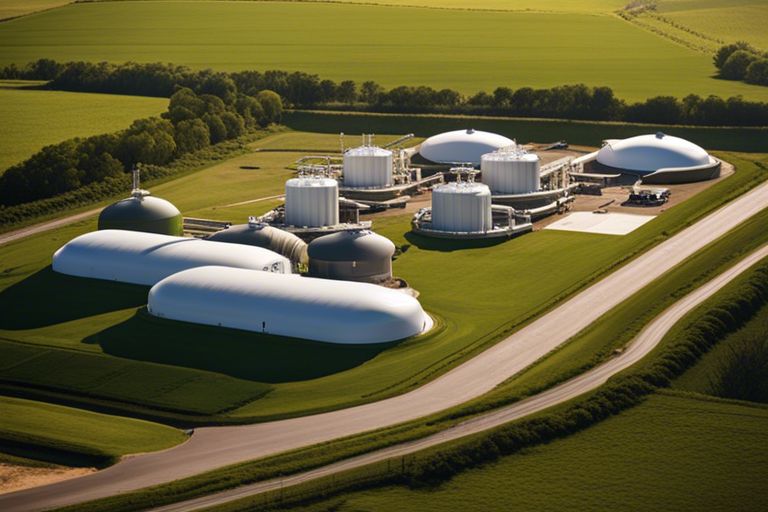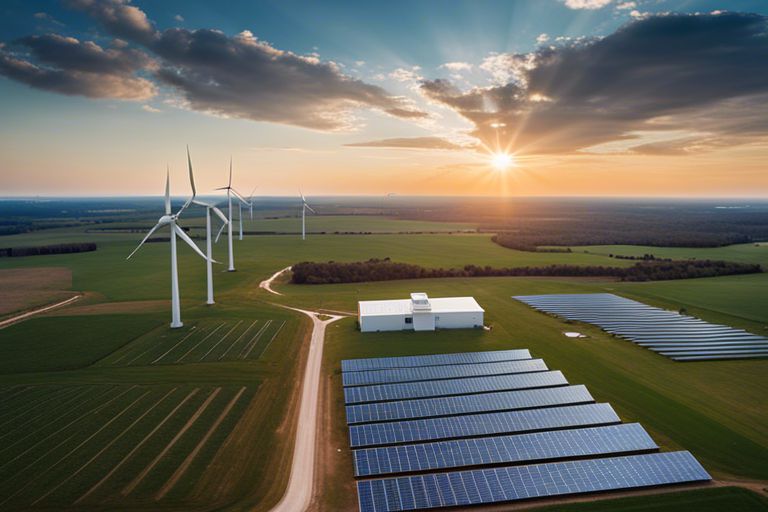Renewable Energy sources are crucial in reducing carbon emissions and transitioning towards a more sustainable future. In this quest, biogas emerges as a powerful player that often goes overlooked. Oklahoma, known for its agricultural prowess, has the potential to harness biogas from organic waste materials such as manure, crop residues, and food scraps. Converting this waste into energy not only helps in managing waste but also reduces methane emissions, a greenhouse gas significantly more potent than carbon dioxide. Implementing biogas technology can provide a reliable source of renewable energy for the state, contributing to its renewable energy portfolio and advancing towards a greener tomorrow.
Key Takeaways:
- Biogas as Renewable Energy: Biogas is a renewable energy source produced from organic materials like agricultural residues, manure, and wastewater, making it a sustainable alternative to fossil fuels.
- Reduction of Greenhouse Gas Emissions: By capturing and utilizing biogas, Oklahoma can significantly reduce greenhouse gas emissions, which contribute to climate change.
- Economic Benefits: Investing in biogas infrastructure can create new job opportunities, support local economies, and reduce dependency on imported fuels.
- Waste Management Solution: Biogas facilities can help manage organic waste by converting it into energy, reducing landfill usage and mitigating environmental pollution.
- Diversification of Energy Sources: Integrating biogas into Oklahoma’s energy portfolio can diversify the state’s energy sources, enhancing energy security and resilience.
Fundamentals of Biogas Production
Biogas Technologies and Processes
One of the key elements in biogas production is the utilization of various technologies and processes to convert organic waste into renewable energy. Anaerobic digestion is the most common method employed in biogas production, where microorganisms break down biodegradable material in the absence of oxygen to produce biogas.
Types of Feedstock Suitable for Oklahoma
With Oklahoma’s diverse agricultural and industrial landscape, there are several types of feedstock that are suitable for biogas production in the state. Livestock manure, crop residues, food waste, organic byproducts from industries, and wastewater treatment plants are some of the key feedstock sources that can be utilized for biogas generation.
| Livestock Manure | Crop Residues |
| Food Waste | Organic Byproducts from Industries |
| Wastewater Treatment Plants |
Understanding the types of feedstock suitable for biogas production in Oklahoma is crucial for establishing sustainable and efficient biogas plants in the state. By utilizing local sources of organic waste, Oklahoma can reduce its carbon footprint, generate renewable energy, and promote environmental sustainability.
- Livestock manure and crop residues are abundant in Oklahoma due to its strong agricultural sector.
- Food waste and organic byproducts from industries provide additional sources for biogas production.
- Wastewater treatment plants can also contribute to biogas generation by utilizing sewage sludge.
- Utilizing a diverse range of feedstock can enhance the efficiency and sustainability of biogas production in Oklahoma.
- Any establishment looking to invest in biogas projects in Oklahoma should consider the availability and suitability of these feedstock sources.
Biogas Potential in Oklahoma
Agricultural Resources and Waste Management
If Oklahoma were to tap into its vast agricultural resources and implement effective waste management strategies, the potential for biogas production could be significant. Livestock farms generate a substantial amount of organic waste that can be converted into biogas through anaerobic digestion. By incentivizing farmers to utilize this waste-to-energy process, Oklahoma could not only manage waste more efficiently but also contribute to its renewable energy goals.
Estimating Biogas Yield and Energy Potential
One of the crucial steps in realizing the potential of biogas in Oklahoma is accurately estimating the biogas yield and energy potential of different feedstocks. Factors such as feedstock composition, temperature, and retention time can influence the biogas production process. By conducting detailed assessments and research, stakeholders can better understand the energy potential of biogas in the state and make informed decisions regarding investments in biogas infrastructure.
Resources
It is crucial for Oklahoma to collaborate with experts in biogas technology and renewable energy to maximize the efficiency and output of biogas production. By leveraging the state’s agricultural resources and implementing effective waste management practices, Oklahoma can significantly reduce greenhouse gas emissions and promote a more sustainable energy future.
Integration of Biogas into Oklahoma’s Energy Infrastructure
Upgrading and Utilization of Biogas
Not all biogas produced in Oklahoma is currently utilized to its full potential. With advancements in technology, biogas can be upgraded to renewable natural gas (RNG), which can be injected into existing natural gas pipelines. This process enhances the value of biogas and expands its potential applications in various sectors, including transportation and power generation.
Policy Support and Economic Incentives
Policy support and economic incentives play a crucial role in the successful integration of biogas into Oklahoma’s energy infrastructure. Financial incentives, tax credits, and renewable energy standards can encourage the development of biogas projects and attract investments. Additionally, establishing favorable policies for interconnection with the grid and creating markets for RNG can further stimulate the growth of biogas utilization in the state.
Challenges and Solutions
Technological Hurdles and Innovation
Unlike other renewable energy sources like wind or solar power, biogas production faces unique technological challenges. The efficiency of biogas production heavily relies on the optimization of anaerobic digestion processes, which can be affected by inconsistent feedstock quality and composition. However, continuous research and innovation in biogas technologies are paving the way for advancements in optimizing biogas production processes and improving overall efficiency.
Environmental Impact and Sustainability Considerations
For biogas to become a more prominent player in Oklahoma’s renewable energy portfolio, addressing environmental impact and sustainability considerations is crucial. Any expansion of biogas production should be accompanied by proper monitoring and management of potential environmental impacts, such as odor emissions, nutrient runoff, and greenhouse gas emissions. These considerations are paramount to ensure that the growth of biogas production in Oklahoma aligns with sustainable practices and environmental regulations.
With proper planning and implementation of environmental management strategies, biogas production can offer significant benefits in terms of waste diversion, renewable energy generation, and greenhouse gas reduction. By utilizing agricultural and organic waste sources for biogas production, Oklahoma can not only reduce its dependence on fossil fuels but also address waste management challenges effectively.

Case Studies and Current Projects
Keep biogas in mind when considering renewable energy options for Oklahoma. There are several case studies that showcase the potential of biogas as a significant contributor to the state’s renewable energy portfolio:
- Case Study 1: A dairy farm in northeastern Oklahoma implemented a biogas digester system, converting animal waste into biogas for energy generation. This project has reduced methane emissions by 70% and provided 50% of the farm’s energy needs.
- Case Study 2: A wastewater treatment plant in Tulsa has been utilizing biogas produced from sewage sludge to generate electricity. This sustainable practice has not only reduced operating costs but also reduced the plant’s carbon footprint by 50%.
Successful Biogas Implementations in Oklahoma
One of the successful biogas implementations in Oklahoma is the integration of biogas digesters on dairy farms. These digesters efficiently break down organic waste, producing biogas that can be used as a clean energy source for the farm’s operations. This has not only helped in waste management but also in reducing the farm’s reliance on fossil fuels.
Lessons Learned and Best Practices
Biogas projects in Oklahoma have highlighted the importance of proper planning, maintenance, and operational monitoring. With a dedicated team overseeing the biogas systems, issues such as gas leaks or equipment malfunctions can be quickly identified and resolved. Training programs for farm staff and regular inspections are imperative to ensure the efficiency and safety of biogas operations.

Future of Biogas in Oklahoma’s Energy Mix
Trends in Renewable Energy and Biogas
After exploring the current landscape of renewable energy sources in Oklahoma, it is evident that biogas holds great potential for growth in the state’s energy mix. With the increasing demand for sustainable energy alternatives and the emphasis on reducing carbon footprints, biogas presents itself as a reliable and efficient source of renewable energy.
Strategic Planning for Increased Biogas Contribution
The future of biogas in Oklahoma’s energy mix relies heavily on strategic planning and investment. The state can capitalize on its vast agricultural and livestock industry to expand biogas production. Developing incentive programs for biogas projects, investing in infrastructure for biogas utilization, and fostering research and development in biogas technologies are crucial steps in increasing biogas contribution to the energy portfolio.
To wrap up
Presently, biogas stands as a promising renewable energy source that can significantly contribute to Oklahoma’s energy portfolio. With its ability to generate clean electricity, reduce greenhouse gas emissions, and provide economic opportunities for farmers and communities, biogas has the potential to play a vital role in the state’s transition to a more sustainable future. By investing in biogas technology and infrastructure, Oklahoma can not only meet its renewable energy goals but also create a more resilient and environmentally friendly energy system for generations to come.
FAQ
Q: What is biogas and how is it produced?
A: Biogas is a renewable energy source that is produced through the anaerobic digestion of organic materials such as agricultural waste, food scraps, and sewage sludge. This process breaks down the organic matter, releasing methane gas that can be captured and used as a clean energy source.
Q: How can biogas contribute to Oklahoma’s renewable energy portfolio?
A: Biogas can contribute to Oklahoma’s renewable energy portfolio by providing a sustainable energy source that can help reduce greenhouse gas emissions, improve air quality, and strengthen energy independence. It can also help diversify the state’s energy sources and create economic opportunities in the agricultural and waste management sectors.
Q: What are the environmental benefits of using biogas as a renewable energy source?
A: Using biogas as a renewable energy source can help reduce methane emissions from organic waste decomposition, which is a potent greenhouse gas. It also helps reduce reliance on fossil fuels, decreases air pollution, and promotes sustainable waste management practices.
Q: How can biogas production help support Oklahoma’s agricultural industry?
A: Biogas production can help support Oklahoma’s agricultural industry by providing farmers with an additional revenue stream through the sale of organic waste for biogas production. It can also help farms manage waste more efficiently, reduce odors, and improve soil quality through the use of digestate, a byproduct of biogas production.
Q: What infrastructure is needed for biogas production in Oklahoma?
A: To produce biogas in Oklahoma, infrastructure such as anaerobic digesters, gas collection systems, and gas purification equipment is needed. Additionally, partnerships with local farms, waste management facilities, and utilities are crucial for successful biogas production and integration into the energy grid.
Q: Does biogas production in Oklahoma receive government incentives or support?
A: Yes, biogas production in Oklahoma may be eligible for various government incentives and support mechanisms, such as renewable energy tax credits, grants, and low-interest loans. These incentives aim to encourage the development of renewable energy projects, including biogas, and help drive the transition to a more sustainable energy future.
Q: How does biogas compare to other renewable energy sources in terms of reliability and availability?
A: Biogas is a reliable and readily available renewable energy source that can be produced consistently throughout the year. Unlike solar and wind energy, biogas production is not dependent on weather conditions and can provide a constant source of energy, making it a valuable addition to Oklahoma’s renewable energy portfolio.




